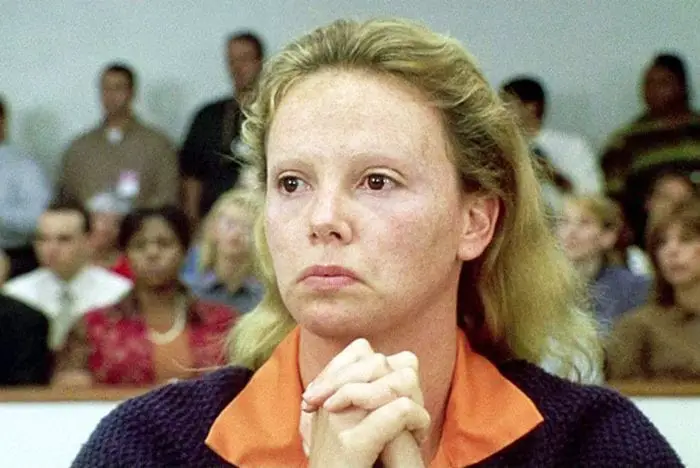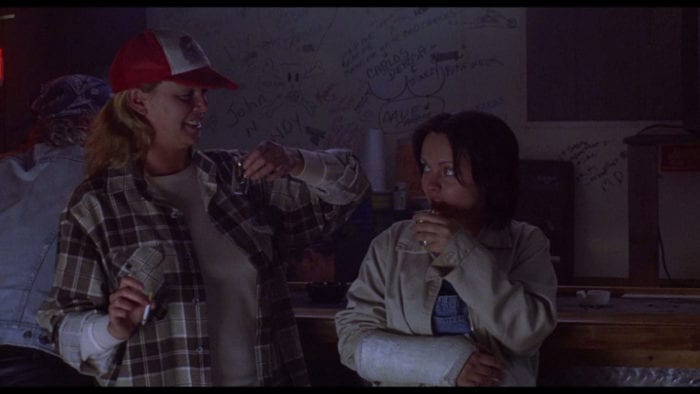Last week, I looked into Aileen Wuornos’ crimes. This week, I want to take a look into her background. The old nature versus nurture debate surfaces as you look deeper into her story to answer the question of how she could’ve ended up becoming one of history’s most notorious serial killers.
Aileen Wuornos was born Aileen Carol Pittman in Troy, Michigan during a leap year, Feb. 29, 1956. Her parents, Diane (nee Wuornos) and Leo Pittman were teenagers (she was 15 and he was 17) who had eloped and were divorced after two years of a toxic marriage. Aileen had a brother, Keith, who was 11 months older. It’s speculated that Diane Wuornos married at age 15 to escape her controlling, abusive father, Lauri Wuornos. However, the boy she chose to marry was the same as or perhaps worse than her father.
According to Sue Russell’s book, Lethal Intent, those who knew the Pittmans said that Leo was abusive toward Diane. He wouldn’t let her go out of the house even to hang laundry outside to dry. He beat her if she disobeyed. He also cheated on her. Leo rarely worked, drank heavily, and was a car thief. Instead of doing jail time, Leo opted to join the U.S. Army in 1955. Diane was pregnant with Aileen at the time. When Leo left, she filed for divorce. She and Leo were officially divorced on Nov. 14, 1955. An allowance she received from the Army helped pay rent on an apartment. Larry Larson and his wife Marge were her neighbors. Diane got a job as a phone operator. Soon, Larry and Marge were divorced and Marge and Diane became roommates. The two babysat each other’s children. [1]
One night, Diane went out and didn’t return. Aileen was six- to nine-months old. Marge had no idea where Diane went and never heard from her again. Marge couldn’t understand it because Diane had always taken good care of her children. Marge took care of Aileen and Keith for as long as she could. Marge had to move back in with her parents and called Diane’s parents, Lauri and Britta Wuornos, in the hopes that would take them in. Lauri was furious but took in Aileen and Keith and eventually adopted them. Her parents found out that Diane was living in Texas. Leo Pittman would eventually be incarcerated in prison on child molestation charges. He hung himself in his prison cell in 1969.
In the docu-series Born to Kill, childhood friend, Karen Gamble, described Aileen as “quiet, withdrawn and scared.” Another childhood friend, Dawn Botkin, said that classmates relentlessly teased her. According to Sue Russell, Aileen also was described as a difficult child whose temper would flare at little or no provocation. Her father, Leo Pittman, and her grandfather, Lauri Wuornos, were described the same way. Lauri was painted by neighbors as being opinionated, hot-tempered, and unapproachable. In contrast to Lauri’s domineering and combative personality, his wife, Aileen Britta Moilanen was described as quiet and introverted. Criminologist David Wilson, comments in Born to Kill, that the fact that Leo Pittman was a violent sex offender could point to genetics playing a role in Aileen’s crimes.
Aileen and Keith were raised with Lori and Barry Wuornos, who they believed to be their siblings. Lori was about the same age as Aileen and Keith. Barry was eight years older. When Aileen was 11-years-old, she and Keith learned that they were adopted. Lauri and Britta Wuornos were not their parents but their grandparents. Lori and Barry weren’t their brother and sister but aunt and uncle. Their biological mother, Diane, was Lauri and Britta’s eldest child. Lauri wouldn’t tell them anything about their real father. Diane was rarely mentioned. When she sent gifts at Christmas, Lauri would get rid of them. They were told that their mother remarried and had two other children named Kathy and Rusty. [2]
Jekyll and Hyde temperament aside, Aileen was described as having artistic talent. However, she only received attention when she misbehaved. When she did anything positive, it was ignored. Aileen said that she was beaten regularly with a brown leather belt that Lauri kept on his bedroom door. He would order Aileen to clean the belt regularly with saddle soap and conditioner. She and Keith complained about the beatings to other children that they knew. Neighbor Cheryl Stacy recalled, “He [Lauri] didn’t treat them like human beings. He treated them worse than anybody would treat an animal.” [3]

Lori and older brother Barry recall grounding and spanking as punishments but not to the extent that Aileen described it. “We got spankings and groundings but we never got beat,” Lori insisted. “We did get yelled at.” In her book, Russell points out that many times in families where abuse and alcoholism are present siblings will sometimes gloss over or downplay abuse. [4]
Barry and Lori’s accounts differ from those of not only Aileen and Keith but also their neighbors. Barry even said that Aileen was popular and well-liked in the neighborhood. He joined the Air Force in 1967 when Aileen was 11, which was about the time her conflict with Lauri began. Lori and Barry remember Lauri Wuornos fondly with a sense of admiration and respect. Others that knew him do not. Aileen recalled her childhood much differently. Perhaps this has to do with a difference in temperament between them. Aileen is described as becoming defiant and had a temper that flared from little or no provocation. Lauri had issues also. Even for a time period when corporal punishment was an accepted norm for parents, the neighbors considered his treatment of the children too harsh.
“It was like a dungeon most of the time,” one friend observed. The Wuornos were lucky if they got a bowl of breakfast cereal, let alone lunch money for school. Sometimes a teacher gave them a loan or other kids shared a sandwich with them. Generally, they took bag lunches because they couldn’t afford hot lunches.” [5]
By all accounts, both of her grandparents also were alcoholics. Lauri reportedly drank up to three bottles of wine a day and Aileen’s grandmother, Britta, died from liver disease. If a parent is emotionally unstable, they’re going to create a toxic environment. If they’ve passed on their instability to children or grandchildren, wouldn’t this make an already unstable child’s behavior worse? As Aileen grew older, she engaged in criminal behaviors such as armed robbery and theft. Her behavior toward others became increasingly violent and she eventually became society’s worst nightmare—a serial killer—a predator with no regard for human life. Is it nature plus nurture that transformed Aileen, an emotionally unstable girl into a serial killer?
In an interview for Born to Kill, forensic psychiatrist, Dr. Helen Morrison said that “Aileen is different. She may have been born to kill but also her environment acted so devastatingly on her that the combination of being born and the environment was unmistakable in leading to the murders.”
Even dysfunctional families can have good times or normal periods. Lauri would take groups of kids, including Aileen, to the movies. He also took them ice skating and camping. Already at age 11, Aileen was engaging in sex acts with boys in town in exchange for cigarettes and loose change. There was a secluded, wooded area of town called “the pits,” where children built forts, hid contraband (Playboy magazines, cigarettes, etc.), and teen couples could meet, out of sight from the watchful eyes of parents. One night, Aileen realized that a group of boys was watching her as she was with a boy. They shouted insults at her as she ran home. As she grew older, her behavior continued. Any money earned went to cigarettes, alcohol, and eventually drugs (mescaline, acid, marijuana, pills).
Frank Tremonti recalled the afternoon that he lost his virginity to Aileen. He was about 12- or 13-years-old and she was approximately age 11 or 12. She kept riding past his house as he mowed his parents’ lawn. During her final pass, she stopped and gave him a note that read, “Meet me at Clark station [local gas station]. For a pack of cigs I will suck and f**k.” He scraped together enough money for a pack and went to the rendezvous. Years later, after Aileen’s arrest, Tremonti admitted that he felt as if his behavior toward Aileen during childhood was partially to blame for Aileen’s behavior as an adult. [6]

Aileen tried to win affection from a couple of boys in the neighborhood but none of them respected her as an individual. She was called names like “cigarette pig” behind her back because she would perform sex acts for cigarettes. She was considered “dirty.” Gary Kopietz was another neighborhood boy who had a few experiences with Aileen. It was during the summer of 1969. Aileen was 13 and Gary was 14. Kopietz said that she was known around town by all the boys. She was known to engage in sex acts with more than one boy. They would wait in line for their chance. No boy would ever consider her to be a girlfriend. Kopietz said that one day a friend rode by on his bicycle and said, ‘Come on! We got Cigarette Pig! We’re gonna go down and f–k her! Get thirty-five cents…” He admits that he took a bath as soon as he got home. “In his eyes, she was a whore, basically, and although he was pleased no longer to be a virgin, he also felt the urgent need to make contact with water.” [7]
Aileen tried to use sex to win genuine affection from her brother’s friend, Jerry Moss, and a boy named Mark Fearn but both rejected her. Kopietz recalled that Aileen claimed that her first sexual experience was with her brother Keith. She told Mark Fearn that she had sex with her grandfather, Lauri. Fearn reportedly witnessed the incestuous relationship between Aileen and Keith. Keith was described as a shy boy who, although embarrassed by his sister’s promiscuity, asked if she could teach him about sex. Their sister, Lori didn’t recall any incest. She said that Keith and Aileen fought all the time. Often they were so angry with each other that the two would refuse to look at each other. [8]
The community that they lived in didn’t help. There was a local couple—Dixie and Alphonse “Chief” Podlack, a middle-aged couple who supplied local kids with alcohol and drugs. Dixie was a former burlesque dancer described as serving as a role model for Aileen. At the same time, Aileen was having sex with her husband. Dixie cheated on her husband with local boys. Drugs and criminal activity were common in Aileen and Keith’s social circle. “Neighborhood crimes centered on car-theft rings, burgling houses, stealing stereos and TVs (a specialty of Keith and his friend, Don), gun-running, and, of course, drug dealing. The latter involved cocaine, heroin, LSD, mescaline, and large shipments of pot. Aileen, with money in her pocket and an appetite to buy, was spoiled for choice.” [9]
Aileen and Keith fell in with a rough crowd at school. Their teen years were spent in a haze of drugs, alcohol, and criminal behavior. The parties got so wild that the police would break them up. Even well-behaved Lori used drugs recreationally. Aileen became addicted. Lori recalled that the drugs made Aileen more temperamental and emotional. Aileen tried to buy friends by sharing her alcohol and drugs, but she was still an outcast. As the other kids paired off, Aileen was left out. However, alone in the woods, boys would pay to have sex with her. When they were with their friends, she was still the “cigarette pig.” [10]
During junior high school, at age 14, school administrators recognized her as having issues. She also had poor eyesight and impaired hearing both of which were not addressed. Aileen refused to wear her glasses and her grandmother denied that she was hearing impaired. Britta insisted that Aileen’s issues were her behavior and not paying attention in class. Britta wouldn’t follow up with a doctor to get Aileen’s hearing checked. [11]
Aileen and Keith developed a habit of hitchhiking and running away from home. Lauri and Britta would receive calls from the local police to pick them up. Aileen began shoplifting at the K-Mart where Britta worked part-time. Britta quit because she was embarrassed by Aileen’s shoplifting. At age 14, Aileen became pregnant and was sent to a home for unwed mothers. The staff noted that she was hostile to the other girls and difficult to get along with. In January 1971, she gave birth to a boy who was put up for adoption. Britta Wuornos died that July.
According to many accounts, Lauri threw Aileen out of the house at this point. She went to live in a wooded area near the Wuornos’ house. Sue Russell gave a different account. She wrote that Keith and Aileen told Lauri that they were running away. Lauri told them that if they did that they couldn’t come back home. This time, when the two ran away, Lauri refused to pick them up from the police station. Aileen was sent to juvenile hall and managed to run away from there. She didn’t try to return home. [12]
Diane Wuornos invited Aileen and Keith to stay with her in Texas but both declined. Aileen hit the road and became a drifter, a hitchhiker who supported herself as a sex worker. On her travels, Aileen met 69-year-old Lewis Gratz Fell. The two married in March 1976, two months after Lauri Wuornos committed suicide at age 65. Fell was a multi-millionaire from Philadelphia who made his money through railroad stocks and shares. They married in Kingsley, Georgia, and their wedding made the society pages of the Daytona Press.
In July of that year, the couple arrived in Michigan. Aileen was arrested at a bar on July 13. She was hustling at the pool table and started trouble with other customers. The bar manager was fed up with her behavior and told her that the table was closed. In response, she hurled a ball, that just missed his head and became lodged in the wall. Aileen was arrested for assault and battery as well as outstanding warrants from the Troy Police Department for drinking in a car, unlawful use of a driver’s license, and not having a Michigan driver’s license. A friend brought her purse to the jail and she bailed herself out. Her brother Keith, age 21, died of throat cancer three days later.
Lewis Fell said that Aileen beat him when he refused to give her more money. He had the marriage annulled and filed a restraining order. Aileen pled guilty to the assault and battery charge on Aug. 4. She received $10,000 from her brother’s insurance. She spent the money within three months on a deposit on a black Pontiac which was soon repossessed and a stereo system (with no home to put it in). She did some jail time for armed robbery, forgery, and theft.

In 1986, Aileen met 24-year-old Tyria “Ty” Jolene Moore at a gay bar in Daytona. The two lived out of motels on Aileen’s earnings as a sex worker. Berry-Dee quotes Tyria Moore’s comments on her relationship with Aileen. Moore said, “Lee was very pretty in those days. She dressed very provocatively and I considered her a real catch. We had some great times. She was a great lover. Very gentle and caring as if she needed my love in return. She was my best friend. But what I admired most was her strength. She was very … er, over-protective of me. No one messed with me when Lee was around. I truly loved her, but I don’t think anyone will understand this. Even when she was drunk, she was funny.” [13]
In Born to Kill, forensic psychologist, Dr. David Holmes, commented that Tyria Moore presented the first opportunity for Aileen to have a stable relationship. She had no significant bond in her life up until meeting Tyria. Up until meeting Tyria, Aileen never had what would be considered a normal relationship. Unattached and unemotional sex-for-money had become the norm for Aileen. Tyria Moore was an “non-threatening” person who offered a chance at a stable relationship based on affection and acceptance. Both Dr. Holmes and criminologist, David Wilson, pointed out that, due to her background and existing psychological issues, Aileen lacked the skills necessary to form a normal relationship.
The two spent four years together until the day that they crashed Peter Siems’s 1988 Sunbird on July 4, 1990. They went off a road in front of witnesses who would later help create composite sketches that would lead investigators to Aileen. When the composites began circulating, Tyria began to worry. She thought about getting out of Florida and even going to see her family in Ohio for Thanksgiving.
On Tuesday, Jan. 8, 1991, two detectives, Mike Joyner and Dick Martin, went undercover as bikers and surveilled Aileen as she went barhopping. They followed her that night to her usual haunts, the biker bars along Highway One. The detectives talked with her and bought her a few beers. Her last stop was a biker bar called The Last Resort. Other officers approached Aileen that night but Joyner and Martin phoned their nearby command post who got in touch with local police and told them to back off. Once they learned of a big party that was set for that night at The Last Resort, the detectives decided that they had to act as soon as possible before Aileen could get lost among the crowd. She was arrested outside the bar. She was told that she was being arrested for an outstanding warrant for Lori Grody (one of Aileen’s aliases) related to illegal possession of a firearm. [14]
After Aileen was arrested, investigators set out to find Tyria Moore. Tyria was living with her sister and brother-in-law in Pittston, Pennsylvania. Citrus County detective, Jerry Thompson, and Marion County detective, Bruce Munster, both flew to Pennsylvania to speak to Tyria. She wasn’t charged with anything but was informed of her rights.
Tyria said that she did know about the murders since the night that Aileen confessed to her that she killed Richard Mallory. “I told her I don’t want to hear about it. And then anytime she would come home after that and say certain things, telling me about where she got something, I’d say I don’t want to hear it.”[15] She told detectives that she didn’t want to know Aileen’s business. She felt that the more she knew, the more she would feel obligated to come forward and report Aileen. “I was just scared. She always said she’d never hurt me, but then, you can’t believe her, so I don’t know what she would have done.” [16]
Tyria agreed to return to Florida with Munster and Thompson. The detectives had a plan for Tyria to get Aileen to confess to the murders. They got Tyria a room at a Daytona motel. She was instructed to tell Aileen that her mother gave her some money and that she came back to Florida for the rest of her belongings. Tyria was to tell Aileen that the police were talking to her family and that she was afraid that the police were going to pin the murders on her. Tyria talked with Aileen in jail by phone. At first, Aileen was guarded as she was aware that the jail phone was being monitored. On the third day, she let her guard down. “Just go ahead and let them know what you need to know…what they want to know or anything…and I will cover for you, because you are innocent. I’m not going to let you go to jail. Listen, if I have to confess I will.” [17]
Aileen confessed on the following day, Jan. 16, 1991. Aileen told detectives that Tyria had nothing to do with the murders. She said that she committed all of the murders in self defense. Aileen said that each of the victims either raped, tried to assault, and/or threatened her. In the end, she was convicted of six murders and received six death sentences.
After her conviction, new evidence surfaced that Richard Mallory had served 10 years in prison for sexual violence. Attorneys thought that Aileen might be granted a new trial. They thought that if the evidence had been presented at the first trial, that perhaps the jury may have voted differently. No history of violent behavior is mentioned in regard to Aileen’s other victims.
Mallory’s status as a sex offender can’t help but cause speculation that as her first victim maybe he was the catalyst for Aileen’s murderous rage. If he did attack her, did this set the stage for the following six murders? At the time this would have occurred, Aileen had already had a lifetime of both receiving as well as doling out abuse. On top of that, she had mental illness and instability present in her background. If Mallory raped her that night, did this cause Aileen to loose her tenuous hold on her sanity?
She was never granted a new trial for the Mallory case. Aileen Carol Wuornos was executed by lethal injection on Oct. 9, 2002. Most reports agree that Aileen Wuornos opted for a cup of coffee instead of a final meal. Her last words were, “Yes, I’d like to say I’m sailing with the rock. And I’ll be back, like Independence Day, with Jesus, June 6th, like in the movie. Big mother ship and all. I’ll be back.”
Works Cited
[1] Russell Sue (2002). Lethal Intent. Kensington Pub.Corp. New York, N.Y., p. 65-66.
[2] Russell, p. 40
[3] Russell p. 34
[4] Russell, p. 35
[5] Russell p. 39
[6] Russell, p. 23
[7] Russell, p. 27-28
[8] Russell, p. 29
[9] Russell p. 46
[10] Russell, p. 46-52
[11] Russell, p. 52-53
[12] Russell, p. 40
[13] Berry-Dee, Christopher. (2003). Talking with serial killers : The most evil men in the world tell their own stories. John Blake Publishing Ltd. London. p. 230
[14] Berry-Dee, p. 216
[15] Berry-Dee, p. 217
[16] Berry-Dee, p. 217
[17] Berry-Dee, p. 218
[18] Berry-Dee, p. 223



